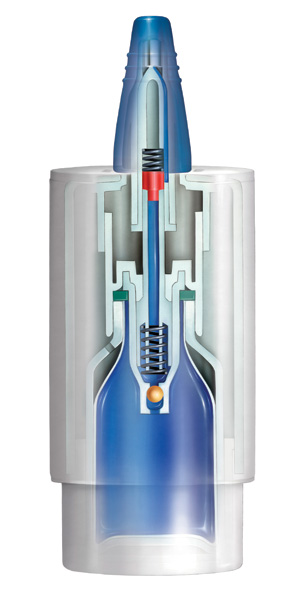Recently, another technological advance joined the list of solutions to the preservative dilemma. After several years of work, the research and development team at Pfizer was able to create an eye-drop dispenser that keeps its contents safe from bacterial contamination—the primary cause of degradation of unpreserved medications. The new design has eliminated the need to add a preservative to the solution.
The bottle was introduced in 2005 as the container for Visine Pure Tears, an OTC formula that mimics the ionic composition, tonicity (salt content), pH and viscosity of natural tears. (Visine Pure Tears is marketed as an option for dry-eye sufferers. Unlike its well-known sister product, it contains no vasoconstrictors.) Pfizer says that thanks to the new bottle design, this is the first preservative-free artificial tears formula to be available in a multi-dose bottle.
 |
| Pfizer's new dispenser includes multiple features that prevent bacteria from entering the container and contaminating the contents. |
Preventing Contamination
The need for preservatives can largely be blamed on bacterial contamination, but for that contamination to occur, bacteria must have access to the solution. A standard bottle of liquid medication is squeezed to dispense drops of liquid, and when the squeezing pressure is released, air is drawn into the bottle to replace the dispensed fluid. That air is likely to contain tiny particles, including bacteria. So, a key element to preventing contamination has been finding a way to prevent air from entering the bottle after tears are dispensed.
As anyone who has bottle-fed an infant knows, a similar problem exists when an infant sucks fluid out of a baby bottle. In this case the problem isn't bacterial contamination, however, but the fact that the infant will swallow some of the extra air that keeps entering the bottle, causing gastric distress. A clever designer eventually constructed a bottle with a collapsible inner sac that eliminated this problem; since the sac doesn't try to return to its original shape, air isn't drawn inside when the infant stops sucking out the contents.
The engineers at Pfizer have used the same principle to solve part of the contamination problem. Uday Doshi, PhD, associate director of the Eye Care Research and Development department at Pfizer explains: "The product reservoir of the Visine Pure Tears multi-dose bottle is, in fact, a dual-wall reservoir," he says. "As the product is dispensed, a mechanism allows the air pressure to equilibrate. The inner wall of the reservoir collapses in on itself. As a result, it doesn't exert any back-pressure." The benefit of this design is one-directional flow of the product from the reservoir to the tip, with no air entering the bottle after dispensing.
In addition, other design features have been incorporated into the bottle tip and cap to minimize any chance of contamination. One of those is a silver coil at the tip, whose inherent antibacterial qualities help to ensure that any bacteria contacting the tip are prevented from affecting the contents. (Silver is used for the same purpose in a number of health-care products currently on the market.) Altogether, Pfizer calls this new design the Airless Antibacterial Dispensing System.
Practical Advantages
To dispense a drop from the new container, the patient clicks the base of the bottle instead of squeezing the sides; this causes the liquid to compress. The multiple valves and airless pump of the AADS system then work together to dispense a single drop. (See illustration, page 27.) As the drop is released, it passes over the silver coil in the tip. Once the drop is expelled the valves close, preventing air from entering the bottle.
This new bottle design offers several practical advantages over alternative ways of solving the preservative problem. Many products intended for individuals who don't like or can't tolerate preservatives have been marketed in single-use vials, but these tend to be comparatively expensive and take up more space. According to Pfizer, the new Visine container holds 300 drops. If one dose is considered to equal two drops in each eye, or four drops total, then this is the equivalent of 75 single-use doses. Pfizer says that compared to the leading single-use competitive product, this bottle saves the consumer 57 to 65 percent of the cost of that number of doses.
Also, consumers are often tempted to store the unused portion of a single-use vial to minimize waste, thus encouraging contamination. The new bottle design eliminates this concern.
Another advantage of the AADS container is that it dispenses exactly one drop. In addition to eliminating the variable size of drops that may be released from a traditional bottle, this prevents extra drops being dispensed unintentionally. In fact, the dispensed drop doesn't hang from the bottle tip, but is ejected with a tiny bit of force, allowing the user to aim the bottle at the eye and not miss, even if the bottle isn't centered precisely over the eye. Pfizer notes that patients using artificial tears dispensed from regular bottles or single-use vials often complain about drops missing the eye and rolling down their face, which is both frustrating and wasteful. This bottle design could minimize or eliminate this problem.
Great Potential
It's clear that this dispenser technology, whose patent is pending, has a promising future; many medicines could eliminate preservatives if sold in similar containers. This could increase the patient-friendliness of those medications and expand their market significantly.
Pfizer declined to comment on future plans for the AADS dropper, but Dr. Doshi did admit that Pfizer is excited about the possibilities. "This technology provides users of tear products with an effective, convenient and cost-efficient alternative to unit-dose products," he says. "In the future, this delivery system could certainly be used in other situations in which eye-drop users want or need to avoid preservatives."



